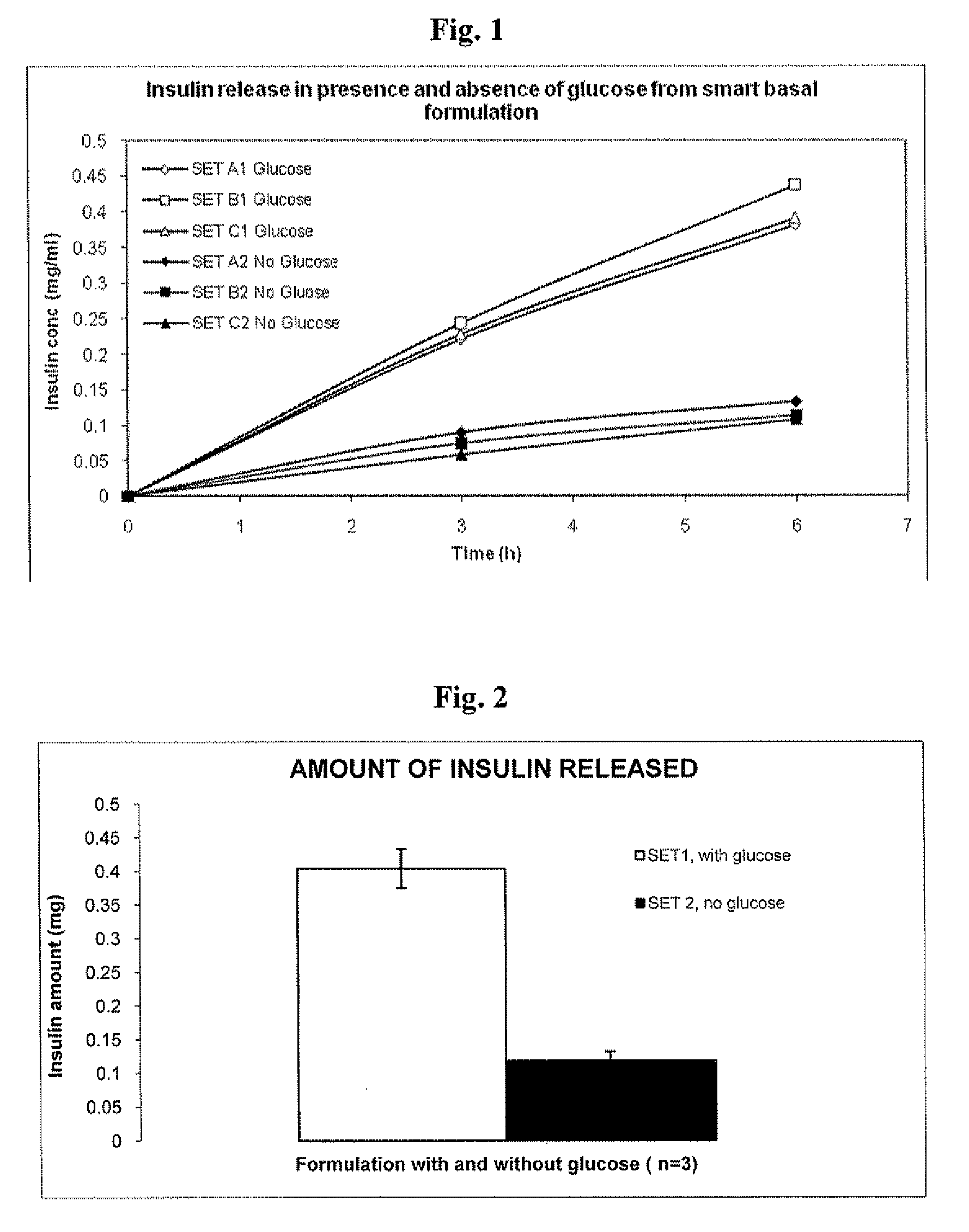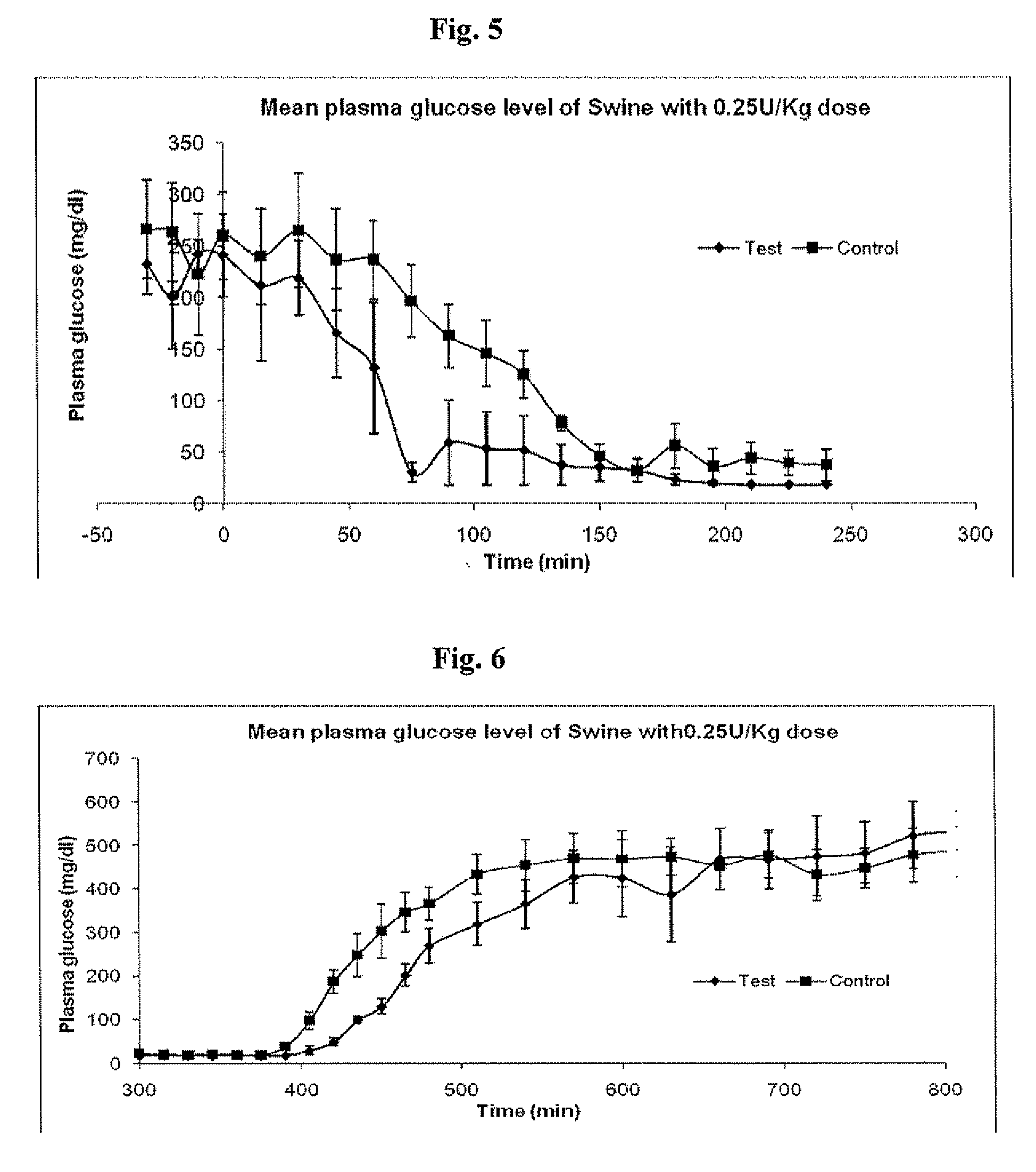Insulin formulations for insulin release as a function of tissue glucose levels
a technology of tissue glucose and insulin, applied in the field of formulations, can solve the problems of insufficient insulin levels, abnormal blood glucose levels, and inability to regulate the ability of proteins, and achieve the effects of reducing blood glucose levels, reducing hydrogen ions, and reducing the production of glucos
- Summary
- Abstract
- Description
- Claims
- Application Information
AI Technical Summary
Benefits of technology
Problems solved by technology
Method used
Image
Examples
example 1
In Vitro Response of System to Varying Glucose
[0137]Precipitated insulin formulations were placed in the upper well of a new transwell device and placed in a 6-well plastic plate. Solutions containing saline with and without glucose were added to the receiver side of the transwell plates. Samples were taken from the receiver compartment of the transwell plate, and media was replaced to maintain a constant volume during the experiment. Insulin concentrations were determined by HPLC.
[0138]Materials
[0139]Glucose oxidase, from A. niger, Sigma
[0140]Peroxidase from A. niger, Sigma
[0141]Insulin Glargine solution 100 U / ml, Sanofi Aventis
[0142]Glucose, Fisher Scientific
[0143]Dulbecco's phosphate buffer saline (DPBS), Gibco
[0144]Saline 0.9% w / v
[0145]Transwell cell culture inserts and six well plates, Falcon
[0146]Methods
[0147]A Smart basal insulin formulation was prepared as follows. 48 mg of GOD and 60 μl of POD were added to the Insulin glargine solution. The solution turned cloudy upon addi...
example 2
Administration of an Insulin Dose of 0.25 U / kg to Diabetic Swine, Comparing LANTUS® to a Smart Basal Insulin Formulation
[0160]Materials and Methods
[0161]Six (6) Diabetic swine were fasted overnight. Morning glucose levels were high and were used as the starting point for the comparison for the Insulin glargine alone (control) with the Smart basal formulation described in Example 1 (test formulation)). Three swine were tested with each formulation. The dose administered subcutaneously to each pig was 0.25 U / kg. Following administration of the formulation, the pigs were monitored and fed at 360 minutes. Plasma glucose levels were determined every fifteen minutes via a commercial glucose strip method (OneTouch® by LifeScan, Inc.).
[0162]Results
[0163]Mean results of three swine are shown in FIG. 4, plus or minus standard error of the mean for each formulation. It appears that the test group responded to the elevated glucose levels both initially and upon second feeding more rapidly than ...
example 3
Administration of an Insulin Dose of 0.45 U / kg to Diabetic Swine Under Normal Feeding Conditions, Comparing LANTUS® to a Smart Basal Insulin Formulation
[0167]Materials and Methods
[0168]Diabetic swine were given food and their maintenance insulin dose the evening prior to the test day. On the test day, animals were administered the test and control doses and then fed at Oh and 360 minutes. The control group received Insulin glargine alone, and the test group received the Smart basal formulation described in Example 1. The dose was 0.45 U / Kg. Animals were administered dose and fed at t=0 minute and re-fed at 360 minutes. Plasma samples were collected and analyzed for plasma insulin and plasma glucose levels.
[0169]Results
[0170]Comparative mean plasma insulin levels (μU / ml) with the standard error of the mean for the control (Mean of N=7) and test group (Mean of N=5) are shown in FIG. 7. Comparative mean plasma glucose levels (mg / dl) with the standard error of the mean for the control (...
PUM
| Property | Measurement | Unit |
|---|---|---|
| concentrations | aaaaa | aaaaa |
| concentrations | aaaaa | aaaaa |
| pH | aaaaa | aaaaa |
Abstract
Description
Claims
Application Information
 Login to View More
Login to View More - R&D
- Intellectual Property
- Life Sciences
- Materials
- Tech Scout
- Unparalleled Data Quality
- Higher Quality Content
- 60% Fewer Hallucinations
Browse by: Latest US Patents, China's latest patents, Technical Efficacy Thesaurus, Application Domain, Technology Topic, Popular Technical Reports.
© 2025 PatSnap. All rights reserved.Legal|Privacy policy|Modern Slavery Act Transparency Statement|Sitemap|About US| Contact US: help@patsnap.com



